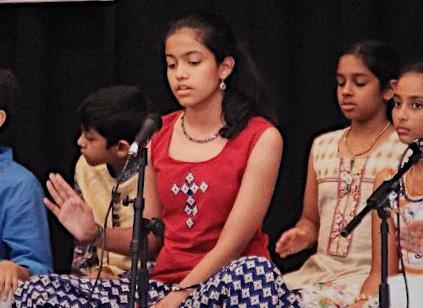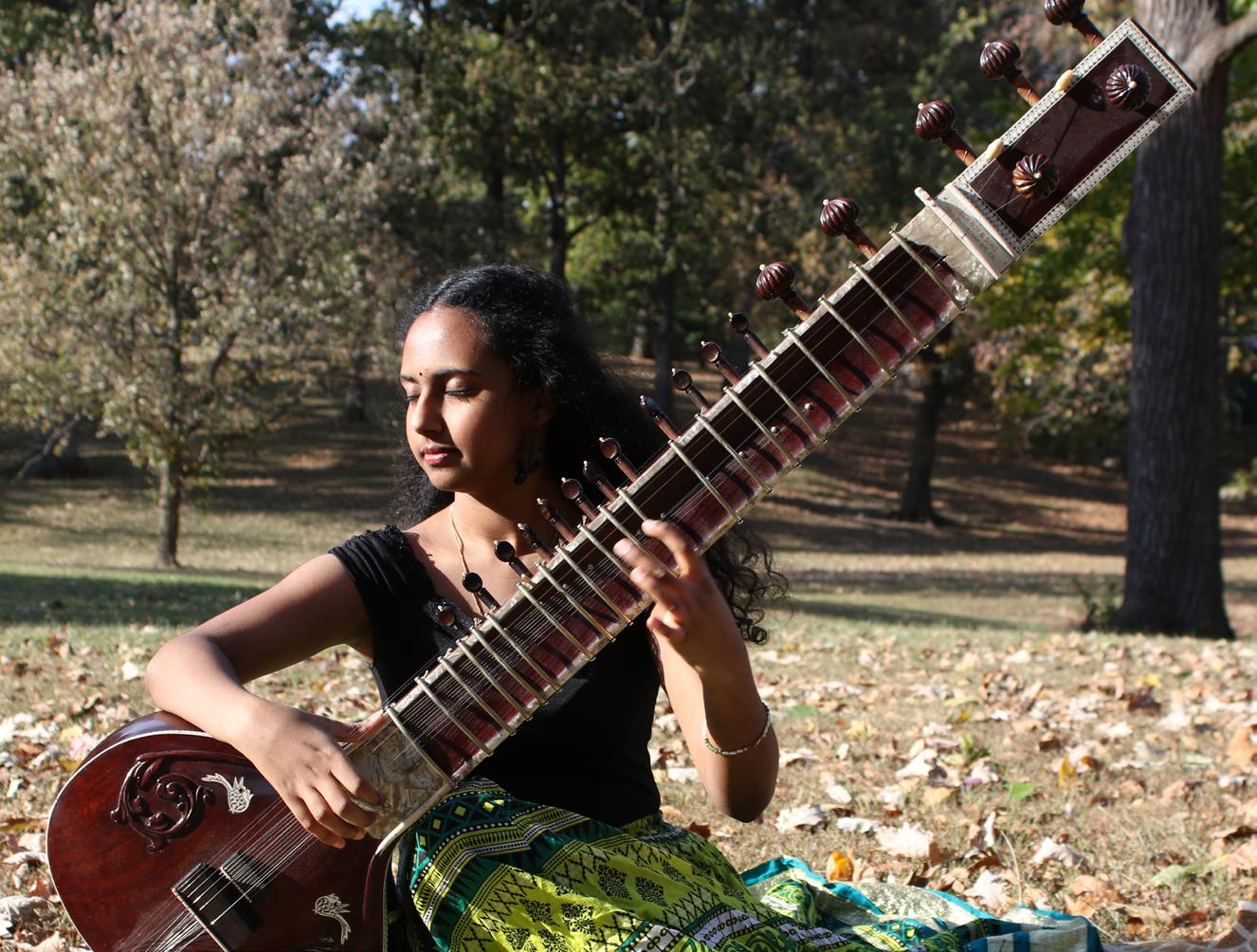
5 minute read
Students practice Indian music and
TRADITIONLEARNING TRADITION Ladue students continue musical traditions of their culture
ABOVE: Sophomore Aditi Navjith performs at a music festival at the Mahatma Gandhi Cultural Center in 2018. Navjith performed at an annual cultural festival organized by her company, Soorya Performing Arts, in St. Louis. “Having that part of my culture made [moving] easier. I was able to stay tethered and not feel like I was losing everything,” Navjith said. (Photo courtesy of Aditi Navjith) RIGHT: Senior Jahnavi Vishnubhotla sits outside while playing her sitar. Vishnubhotla has been playing the instrument for almost six years. “I practice so much that my fingers know what they’re doing already,” Vishnubhotla said. (Photo by Laura Zoeller)
Advertisement



ADITI NAVJITH
OVIYA SRIHARI features editor
SS oft notes ring throughout the temple, curls of incense hang in the air and colorful flowers adorn temple altars, but in this moment, sophomore Aditi Navjith is the center of attention.
Sitting cross-legged in traditional attire before her audience, Navjith sings to celebrate the Hindu holiday of Ganesh Chathurthi. This was the last time Navjith would sing at a religious festival before her move from India to the United States in 2017.
“My dad talks about [how] when I was little, I showed interest in music, which I think is so cliche,” Navjith said. “He plays four or five instruments and sang. My mom is a dancer who could have become a professional. Arts and culture is important in my family, and it was a choice between music and dance. For me, it was always music.”
Navjith quickly began training in a variety of musical disciplines, from show choir and piano to Indian carnatic music, a classical music genre specific to South India. However, when Navjith first began carnatic music lessons after moving to St. Louis, it didn’t exactly feel like smooth sailing.
“It was really intimidating. I was [singing] with a ton of high schoolers when I was in seventh grade,” Navjith said. “They all knew each other, and I didn’t. I was a tiny seventh grader who just moved from India.”
Navjith believes her persistence in the face of moving paid off. Carnatic music is notoriously difficult to master, but it can easily be dismissed by Western audiences unfamiliar with the genre, which Navjith finds frustrating.
“If I told someone that I did Indian classical music for this many years, it wouldn’t mean as much as it would to someone who’s Indian,” Navjith said. “I wanted to quit because I didn’t see the point anymore. Performances didn’t happen as often because we didn’t live in a community of people that appreciated [carnatic music]. I thought it was lame because it was not what my friends who sang here did. They all sang Western music.”
At times, Navjith feels alienated as a carnatic singer in a world of Western music, but her mastery of the genre helps keep her grounded in her Indian culture and Hindu faith. Even years after moving from India, the thread of music still traces back up her family tree and gives her a way to connect with her relatives.
“My grandparents love that I [sing] and [that] I was able to make them proud,” Navjith said. “It was something that we could bond over, something that we had in common, something that made [us] happy. Since Indian classical music tends to be religious, it reminds me of the temple and being around family and friends.” p
JAHNAVI VISHNUBHOTLA
ERIN TURKIELTAUB health & sports editor
SS tares from nearby bystanders are drawn to the oddly shaped case carried by senior Jahnavi Vishnubhotla as she boards a flight for her next performance. A guitar? No, the case is too skinny. A cello? It can’t be, the neck is too slim. What lies inside the mysterious box is a sitar, an instrument native to India that mesmerizes its listeners with a unique sound. After spending a significant amount of time practicing Indian Classical dance, Vishnubohtla, along with her parents, decided to immerse herself into musical cultural practices. It was then decided that she would begin taking sitar lessons. Unfortunately, in 2018, Vishnubhotla’s teacher passed away. She now takes lessons over Skype with his son, who lives in Philadelphia. “We looked up on Google ‘sitar teachers near me,’ and we found a world-famous sitar teacher and player who lived down the street from us. It was crazy,” Vishnubhotla said. “I went there and he just took us in with open arms and I think I was his youngest student, and the youngest woman too because sitar is a very male-dominated instrument.” The sitar, usually made from wood, is composed of a long neck and a rounded end called the tumba, which is traditionally made from a gourd. At the neck of the instrument, there are frets, along with six strings on top and 13 or 14 strings on the bottom. “One main thing that differentiates the guitar from the sitar is that on the guitar, you play chords with all of your fingers,” Vishnubhotla said. “On the sitar, you mainly use [the pointer and middle finger] and we pull the strings to make the sound fluctuate.” Senior Noah Avigad has had the pleasure of listening to Vishnubhotla play the sitar and has gained a significant amount of knowledge on the instrument from her. “You feel admiration when you watch them play because you know how hard it is,” Avigad said. “I’m sure for a lot of Indians [playing gives a] sense of pride because it’s a really intricate and unique instrument only in India.” Senior Ben Rose has been playing in the school band with Vishnubhotla since seventh grade. During their time playing together, Rose has learned about the unique intricacies of the sitar. “Her sitar playing made me feel like I had a lot to learn,” Rose said. “It seemed super complicated to me, and since it was the first time I had really seen or heard one, I was in awe over how easily she was able to play beautiful music on such a complicated instrument.” p
SETUP SOUNDMIC STAND: Indian carnatic music is traditionally sung or played sitting cross legged.
SETTING THE STAGE: the progression from stage to singer
illustration by | DANIELLE ZHANG
SRUTI BOX: An electronic instrument used to provide a base pitch (sruti) for carnatic singers to tune and harmonize with.

TABLA: Twin hand drums used for accompaniment alongside singers in Indian carnatic music.
INSTRUMENTS

SITAR: A stringed instrument that can be played alone or used for accompaniment.









